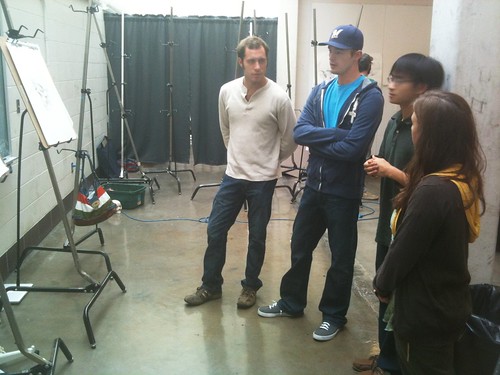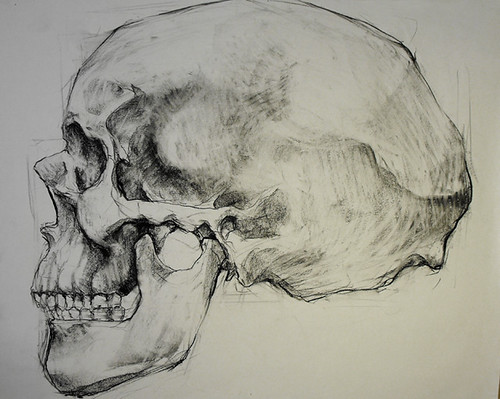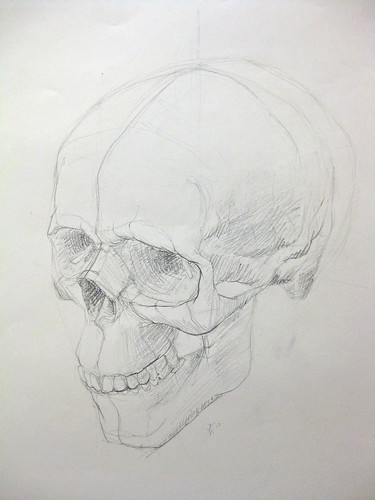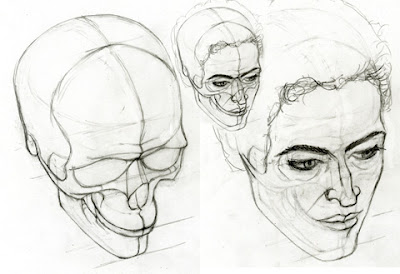Why Life Drawing?
"Analyze the model, don't copy the model"
Never Underestimate the Power of
Life Drawing
Master teacher Glenn Vilppu muses on the importance of life drawing in animation.
By Glenn Vilppu
This article first appeared in Animation World News, June 1, 1997.
It always comes as a bit of a shock for students and artists preparing portfolios for animation industry positions that, almost without exception, what the studios first want to see are figure drawings from life. They don't want to see caricatures, cartoons, or copies of the studio's characters. They want traditional, classical figure drawing.
Why traditional figure drawing?
First, let us look at what skills are needed in good animation drawing.
-
At the top of the list is the ability to communicate movement and personality through drawing. By using simple lines an artist should be able to give a figure a real sense of life and individuality, not just an action pose or stereotypical expression.
-
Next on the list is to be able to draw three dimensionally, to make the characters feel like they are not only individuals, but that they exist in a real world.
-
Since the characters we create and work with are products of our imagination, the animation professional has to be able to draw from his imagination.
-
Next on the list is the ability to consistently draw the same character using the same forms, proportions and details in the particular style that has been set for the production.
As you can see, the list is asking for a high level of skill, and we haven't even touched on imagination, story telling and inventiveness yet.
Modern Renaissance Drawing
So, how do you know an artist has these skills?
Figure drawing has been the standard measurement of an artist's skills for hundreds of years, probably from the moment we first started capturing the living world around us. The Renaissance artist was judged by much the same standard as the animation artist is today. The great masters of the past were first story tellers. They had to be able to create figures that the viewers could empathize with so that stories were brought to life with a sense of realism and believability.
"Animation drawing is, in essence, the closest thing we have to classical Renaissance drawing today."
The Renaissance artist primarily created figures to fit an ideal of perfection using simple volumes to construct figures. The constructions of Raphael are no different than many model sheets you see for classical animation. In traditional drawing, this is referred to as plastic drawing, or "using synthetic forms". This allowed the artist to create fantastic imaginary worlds peopled with figures, in the most part, drawn from imagination.
The beginning compositional sketches of all artists are more similar than they are different. The goal is the same, to capture the sense of the abstract total. A compositional notation by the Mannerist artist Tintoretto would fit in quite well with rough layout and story sketches from our current major studios. The artists of the past are the inspiration and yard stick of quality that we still use.
To draw the human figure well from imagination you must first be able to draw the simple forms of construction -- the sphere, box, cylinder and cone -- from memory, in any position and combination. The famous Flemish artist Peter Paul Rubens said that "you can draw anything using a sphere, box, and cone." These simple volumes are the foundation of good figure drawing, and are the fundamental tools of figure construction. These "tools" not only help you to draw the figure from imagination but to see the forms of the model.
"A portfolio will almost automatically be rejected if the figures inside do not have a clear sense of volume and unambiguous space based on model observation."
Form and Technique
It is important to understand the difference between animation drawing and drawing for illustration.
-
As I have already mentioned, in animation we draw almost exclusively from imagination, and hence need to be able to construct a figure from the mind's eye.
-
In illustration, the artist will generally acquire a model or use photographs to work from if needed. The illustrator also only needs the one particular view that he or she is going to use. As such, the training tends to develop a strong ability to copy a model as well as different techniques for communicating the image.
In my Figure Drawing for Animation classes, I am continually telling the students that we don't copy the model. We analyze the model.
As for technique, the animation artist must focus on describing form with as little individual technique as possible. An animation is a collective work from many artists. Each artist's work must blend in with the direction of the total production and not draw attention as an individual style.
 |
| Gesture sketch by Glenn Vilppu |
Of course, another reason for requiring a degree of skill at human figure drawing is that a lot of animation is based upon human characters. The ability to change real forms into animation forms requires knowledge of the former.
"You cannot draw something if you don't know what it looks like."
Consequently, an animation candidate's figure drawings must show a fair degree of human anatomy comprehension.
Problems while drawing from a human model, bring into question not only the artist's understanding of the figure, but also the ability to be able to follow a model sheet. As humans, we are so tuned into the subtleties of our forms that a high level of skill and development are needed by an artist to create forms that may seem childish. In fact, this feat is often the culmination of many drawings of the human figure by a talented artist whose skills have been fully developed.
Of course, there are many exceptions to the above. We have all seen the success of characters created by artists with very little formal training. While our industry is better for these exceptions, I personally, would bet my career on my artistic skills while I tried to develop that next Saturday morning superstar. However, keep in mind that whenever asked a question about a particular drawing, my late friend Don Griffith, the former head of the Disney layout department, would first tell you what he would do, and then he would invariably shrug his shoulders and say, "Its your career!"
Glenn Vilppu teaches figure drawing at the American Animation Institute, the Masters program of the UCLA Animation Dept., Walt Disney Feature Animation, Warner Bros. Feature Animation and Rhythm & Hues Studios. Vilppu has also worked in the Animation industry for 18 years as a layout, storyboard and presentation artist. His drawing manual and video tapes are being used worldwide as course materials for animation students.

















